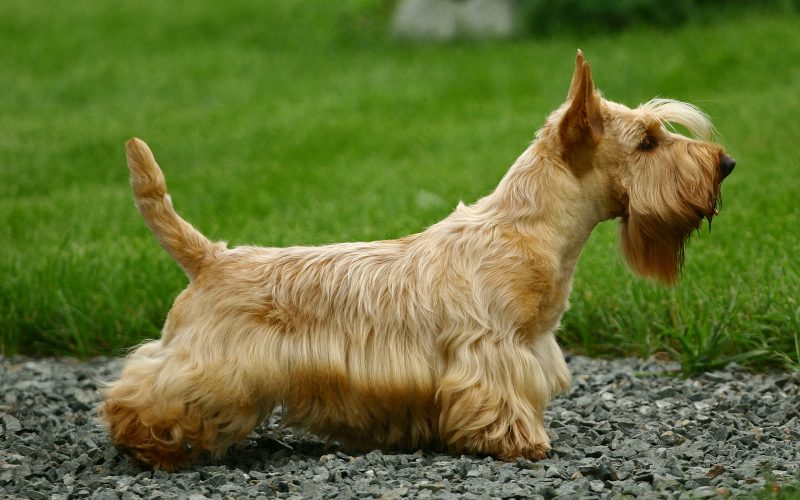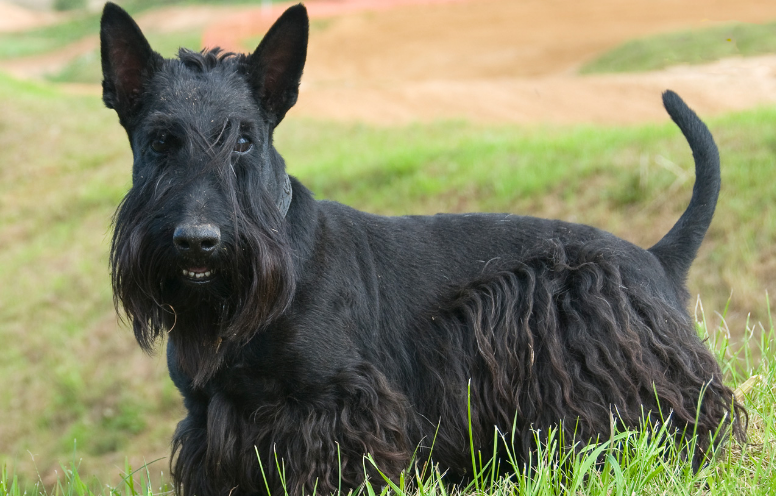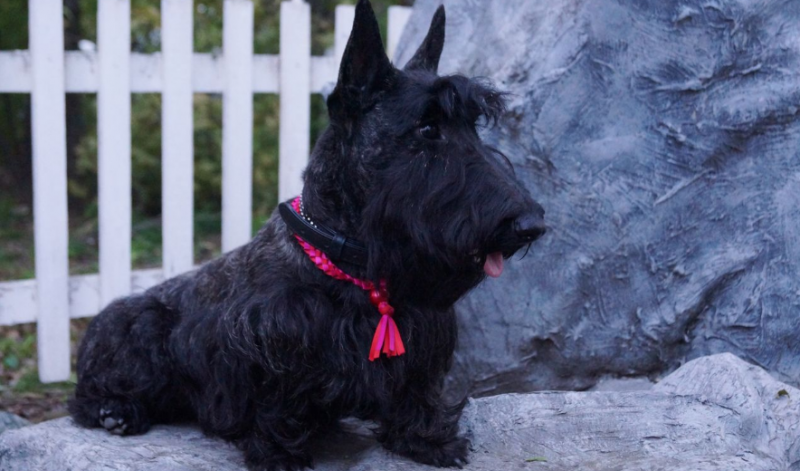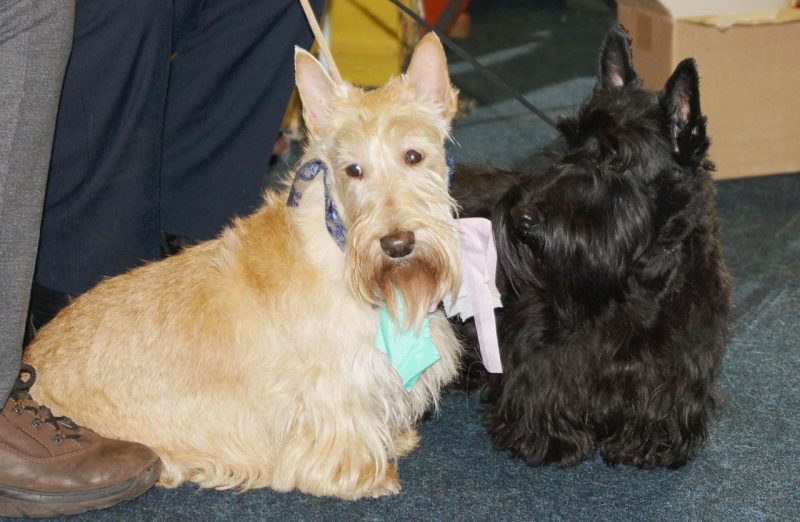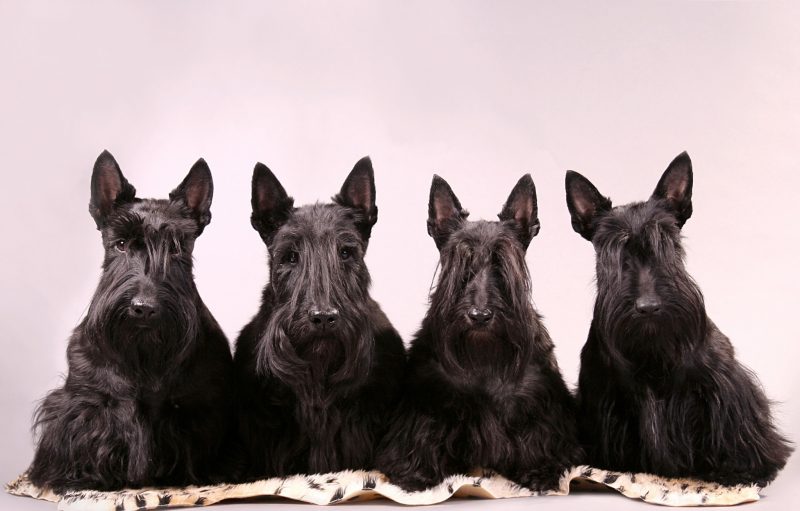The Scottish Terrier, aka Scotch Terrier, is a small and cheerful dog with a strong neck and muscular short legs. Back in the 19th century, Count Dumbarton spoke of her with love, calling him a "little stubborn politician." What is the breed today, consider below.
Material Content:
Origin history
This small terrier was known even in the Middle Ages, when it was used as an assistant hunter for small game, as well as a protector of supplies from rodents. But before earning the right to perform such tasks, the dog had to prove his skills. She was baited by a badger, and if the terrier emerged victorious, then he was worthy to join the human family.
But in those days there was no division of terriers into groups. The formation of a separate breed, known as scotty, or scotch terrier, was due to the efforts of Captain Mackey, who carried out the selection of animals with a specific appearance, subsequently crossing them among themselves.
Description of the Scottish Terrier
Due to its size, the dog, which is considered very small, is classified as a mini-breed. On average, her body weight does not exceed 10 kg. But even today, the instinct of a hunting burrow breed sometimes wakes up in a dog that has become decorative, due to which it becomes an even more coveted mischievous pet.
Scottish Terriers are very active and love constant communication. According to the description of the breed, these are strong-willed animals that test all members of the family who are not the leaders of the "flock."
They are faithful, but close contact is established only with the leader and the maximum of another household. Thanks to their keen mind and sensitivity, they succumb to training and unmistakably draw a dividing line between praise and criticism.
Life span
The average life expectancy of a Scottish Terrier dog, which is often referred to the group of small breeds, is 12 to 15 years.
The main factor that shortens or prolongs the animal's age is the person on whom such important components depend as:
- proper care;
- balanced diet;
- pet activity;
- attention and care.
When the terriers are provided with optimal keeping conditions, taking into account the peculiarities of the breed, when the owner takes care and attention in relation to the pet, the dog's age is significantly extended. There are cases when four-legged pets crossed the fifteen-year threshold of life.
Purpose and character
A dog bred for hunting is today most often used as a companion. After all, the character of the dog, along with the appearance, fascinates people. The animal of this breed has English equanimity. Under the aristocratic appearance is a hunter who, even in the last century, pulled foxes and weasels from holes.
Despite restraint, four-legged representatives of the breed can have fun and play pranks. The Scots have a sharp mind and a stubborn disposition. Interestingly, usually fussy terriers at the sight of a rat can burst into barks and throw themselves at the rodent. Therefore, a systematic and consistent upbringing is indispensable. But it is worth noting that the representatives of the breed do not like training, all the more debilitating.
On a note! The scotch terrier gets along well with children, so it often becomes a member of a family with little tomboys.
Breed standard and puppy selection
External signs that thoroughbred representatives of the Scottish terrier should have:
- the head is rather large with a smooth transition from the forehead to the muzzle;
- the nose is dark with wide nostrils;
- muzzle - elongated;
- jaw - correct bite;
- eyes - slightly slanting, almond-shaped;
- ears are erect, high set;
- physique - compact, quite muscular, with a straight back and a wide chest;
- limbs - strong (especially hind), short;
- tail - medium length, straight and thickened;
- weight - 8.5 - 10.5 kg;
- growth at the withers - 25 - 28 cm;
- coat - long with undercoat;
- color - black Scottish terrier is typical, but lighter shades of wool and even striped colors are acceptable (white - marriage).
Despite the fact that a dog can be assigned to one of the classes - show, brid, pet - it must always comply with breed standards.
How to choose purebred and healthy puppies of a Scottish terrier?
By buying a pet so that it delights the owners with its excellent health and sonorous barking, it is necessary to take full responsibility.
Take into account:
- Place of purchase. You should not buy a puppy in a spontaneous market where you can come across unscrupulous breeders. Such a purchase can only be made in specialized nurseries, where the future owner will receive professional advice from dog handlers and see the parents of the kids.
- Appearance - activity, playfulness, fatness.
- Health status. The puppy should have clear eyes, clean ears and a wet nose.
Purebred animals must have a metric, and a veterinary passport in which marks on the corresponding vaccinations are also of no small importance.
Maintenance, care and feeding
The scotch terrier does not need a lot of space, so he feels comfortable in the apartment. In a private house, he can also live without labor, but do not leave him in the street for a long time: a dense undercoat does not save the animal from the cold.
For a comfortable stay, the terrier needs to take a special place to relax away from drafts and heating appliances. The pet should also have unhindered access to clean water. Every day the dog needs to be walked twice. At this time, he will not only relieve the need, but also hesitate. The dog should walk on a leash in order to avoid the situation when the instinct of the hunter wakes up in the animal, and he will rush at the cat's door with all his legs.
Caring for a representative of the breed is quite simple:
- Wool. Since the scotch terrier has long hair, prone to the formation of tassels, it is recommended to comb it out systematically, not forgetting the beard, and grooming every 2 months. If the dog does not participate in the exhibitions, then you can simply haircut it twice a year. Bathing is carried out as necessary using special shampoos and conditioner.
- Eyes and ears. The organs of hearing and vision should be kept clean, therefore they should be regularly inspected and, if necessary, wiped with cotton swabs dipped in a special solution.
- Claws. Horn formations should be trimmed monthly, for which the pet needs to be accustomed to the procedure from an early age.
- Teeth. To avoid caries formation, they should be systematically cleaned with special brushes with paste.
It is important to plan to visit a veterinary clinic, where qualified personnel will be examined and vaccinated by age.
You can feed your pet with both dry premium food and natural food. If the owner has the time and wants to cook the terrier on his own, then he must observe the approximate proportion of the products in the preparation of the diet. Most of the meat is given with the addition of offal and fish, cereals are also prepared as an additive, fruits and vegetables are given. We must not forget about special mineral complexes that can be purchased at veterinary pharmacies.
Training and education of a scotch terrier
The hunting breed of dogs was originally bred to work independently, without a human being. This led to stubbornness in character. Therefore, in order not to suffer from a pet’s self-will in the future, one should start training from an early age by laying down the standards of behavior that are expected from a dog.
If the owner has free time, then he can practice the obedience course with the terrier on his own. Otherwise, you should contact the professionals.
At the same time, one of the important elements of training is accustoming to walking on a leash. In general, it is not recommended to lower the dog from him altogether, since when he sees potential prey, the scotch terrier can immediately explode after it.
Another reason why you need to start training from a very young age is because scotti is a mood dog. When training, do not forget about the sensitivity of the pet, which is able to catch notes of criticism in the voice of the owner. For improper execution of the command, it is enough to scold the dog, in no case resorting to violence. If the task is completed, then do not skimp on the praise.
Advantages and disadvantages of the breed
Scottish terriers with their unusual appearance, which conquers many people, have their own advantages and disadvantages.
Among the first stand out:
- courage;
- pride and independence;
- determination and strength;
- affection and devotion.
However, there are also disadvantages:
- stubbornness;
- the need for serious education;
- alertness and even aggression towards strangers.
The Scottish Terrier is an English aristocrat, before the acquisition of which it is necessary to carefully study all the characteristics of the breed.




